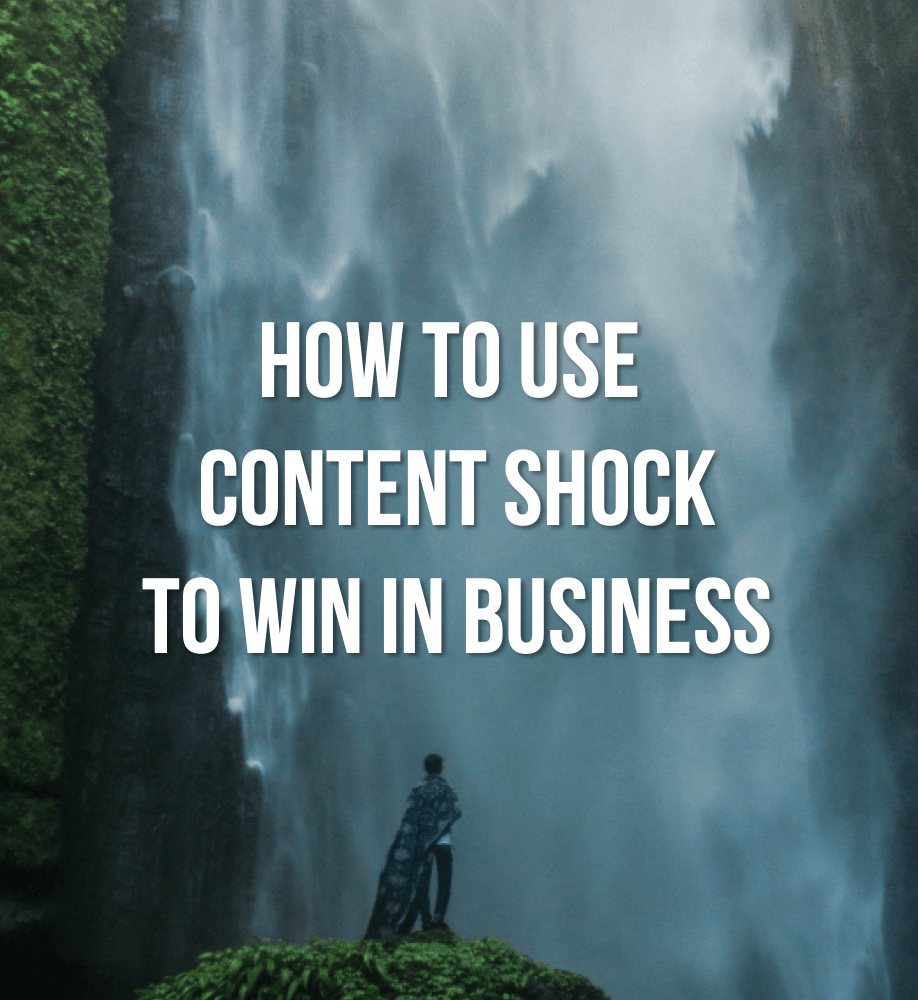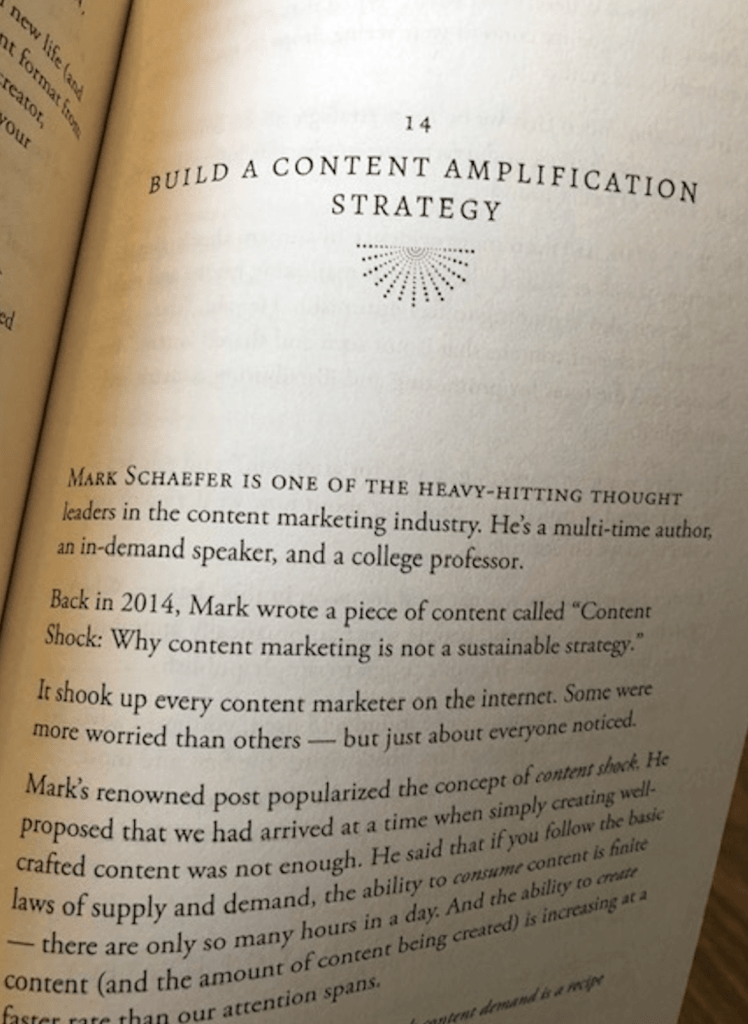
A few weeks ago I received this question from a reader:
“It’s been many years since you wrote the blog post about Content Shock. I wonder if after this time there are any updates or new thoughts about it since you first wrote the article?”
This question is remarkable in that

a) somebody still remembered it, and
b) the person is still curious about the topic
Indeed, “Content Shock” — was probably the most impactful post I’ve published. It is still regularly referenced at conferences, in books, and on dozens of blog posts every month. See the photo here of an entire chapter about Content Shock in Master Content Strategy by Pamela Wilson.
The term has become a neat, short-hand description for the problems we face marketing against an unbelievable tsunami of new content.
I didn’t consider the piece exceptional or controversial when I wrote it. It’s common sense … simple economics. All you had to do was look at the trend of exploding volumes of content and predict that it was about to get very uncomfortable for anybody depending on content marketing as a key part of their business strategy.
The promise of easy and predictable results from content marketing is over. It has been for some time.
The outfall
In the article, I predicted that content marketing would become more expensive to maintain and less relevant for some businesses as competition increased. I received thousands of comments on the article and more than 5,000 posts have been written about the idea. So it certainly sparked a useful dialogue!
About 99 percent of the observers agree with me, but the initial furor was created by the weight of the small minority who disagreed — industry leaders like Robert Rose, Marcus Sheridan, Joe Pulizzi, Michael Brenner, and Brian Clark. Most of these fellows have since recognized that I had a valid point (and some even apologized!). Anybody working in marketing today recognizes that the sheer density of content in our world has made it exceedingly difficult to compete compared to the good old days of 2014 when the post first appeared.
So let’s answer the question. What are the new insights about Content Shock we can take forward with us into the next five years? Are there any new insights since I first wrote the post?
The quality myth
One of the recurring rebuttals to the Content Shock idea is that the problem isn’t too much content, it’s too much bad content. My question to those people is, “says who?”
The problem is not just an explosion of bad content. There is also an explosion of amazing content — and that is the real problem.
Here’s an example.
I’ve been a contributor to Harvard Business Review for about five years. When I started, it was not too difficult getting my articles accepted. Now, almost all of my posts are rejected. The editor explained: “Mark, you do great work and five years ago I would have run these articles. But today, I get five times the number of submissions so the quality level has gone up and up. Keep trying.”
I am clearly a casualty of Content Shock in this example, but not because there is too much bad content. There is too much good content.
Did I keep trying? No, at least for now. The cost of increasing my quality became higher than my return of publishing at HBR. And when that happens, publishers drop out of the content game, as I predicted in my original post.
That is a tangible example of the economics of increasing content density in a niche — driven by great content, not lousy content.
Content Shock IS the strategy
Most content marketers have misunderstood that Content Shock is not necessarily a threat, it can also be their primary strategy.
If you’re really in the content game, you know there are two basic winning hands to play:
1) create must-see content that establishes you as an indispensable authority or
2) overwhelm an un-saturated niche with so much relevant content that you win the SEO war.
In either case, you must provide enough consistent, excellent content that you dominate your topical niche. In essence, your strategy is to create content shock in your industry!
The strategy is clear-cut.
- Find an un-saturated content niche
- Rapidly fill that niche with helpful, high-quality content
- Keep producing content in that topical niche that is relevant, consistent, and superior.
Here is a detailed case study on how content shock can be used to your advantage.
Riches in the niches
Content Shock is not impacting every industry equally. There are still lots of opportunities out there in unsaturated niches. The key is to accurately recognize that opportunity.
Recognizing the information density in your industry is the single most important implication of Content Shock! The first step in any content strategy is not surveying customer needs, setting up a blog, or coming up with a content calendar. It is accurately and thoroughly assessing the existing content density in your marketplace. Here is an article on content saturation to help you do that.
This is so critically important. Unless you first assess the content density in your niche (are you in Content Shock?) you cannot produce an effective marketing strategy. Once you complete this assessment, you can confidently determine your opportunities to maneuver.
If you’re in an unsaturated niche, you have a huge content marketing opportunity before you. But if you’ve discovered overwhelming opposition, there are still strategies to maneuver and succeed even in an environment of significant content saturation.
Content Shock isn’t a trend, it’s a wave.
A few years ago, I attended a panel about Snapchat at Social Media Marketing World. Snapchat was red-hot and one of the panelists explained that this was the place to be because engagement levels were so high!
This claim was not sustainable. If the platform really did take off, it would attract a flood of content producers and soon Snapchat would be in Content Shock, too. Sure enough, the very next year, these same panelists were lamenting how their engagement levels had dropped like a rock in the ocean of new content.
Content Shock is not a one-off trend. The theory can be applied to any platform that becomes popular and attracts massive attention. The wave of hype and then disenchantment repeats itself continually. We’ve seen Content Shock overwhelm our efforts on Facebook, YouTube, and any other place where content becomes popular.
You can see the same thing happening on television programming right now. Netflix, Amazon, Apple, Disney, and even Walmart are throwing billions of dollars into original programming to try to capture valuable consumer attention. Who loses when people spend all their time watching Stranger Things and Game of Thrones? Fans of those programs naturally have less time to watch network TV, read books, and consume corporate blog posts and videos.
When Disney announced The Mandalorian, the first Star Wars based television series. It said it was spending a whopping $100 million on 10 episodes. The reason is simple. To power its way over established streaming services like Netflix and HBO and attract new subscribers, it will have to out-gun shows like Game of Thrones.
So do you.
You don’t have to be Game of Thrones exactly, but you have to be the Game of Thrones — or better — in your specific content niche.
Strategy going forward
Content Shock is part of our marketing reality in a noisy digital world. So, we need to adopt, adapt, adjust.
Recognizing the continuous dynamics of Content Shock is the most important part of content marketing strategy today. Without incorporating the reality of Content Shock into your plans, you’re wasting your time and money. This means:
- Accurately assessing where your business and industry stand in terms of information density
- Creating a content strategy based on your ability to maneuver within the content density reality of your niche
- Continually assessing your progress and monitoring the density of your niche
- Committing to a long-term content strategy of relevance, consistency, and superiority to stay at the top
Exploding content competition doesn’t have to be intimidating or depressing. It is what it is. Let’s recognize the challenge and do what great marketers have always done — find a way to overcome and use the situation to our advantage.
 Mark Schaefer is the executive director of Schaefer Marketing Solutions. He is the author of some of the world’s bestselling marketing books and is an acclaimed keynote speaker, college educator, and business consultant. The Marketing Companion podcast is among the top business podcasts in the world. Contact Mark to have him speak at your company event or conference soon.
Mark Schaefer is the executive director of Schaefer Marketing Solutions. He is the author of some of the world’s bestselling marketing books and is an acclaimed keynote speaker, college educator, and business consultant. The Marketing Companion podcast is among the top business podcasts in the world. Contact Mark to have him speak at your company event or conference soon.
Follow Mark on Twitter, LinkedIn, YouTube, and Instagram.
Illustration courtesy Unsplash.com


